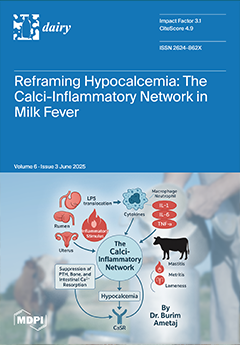Utilizing agro-industrial by-products to feed livestock is crucial for environmental protection and, simultaneously, lowering production and feeding costs. In light of these aims, in this study, two trials were conducted to evaluate the impact of jojoba meal (JJM) on Awassi ewes’ milk properties,
[...] Read more.
Utilizing agro-industrial by-products to feed livestock is crucial for environmental protection and, simultaneously, lowering production and feeding costs. In light of these aims, in this study, two trials were conducted to evaluate the impact of jojoba meal (JJM) on Awassi ewes’ milk properties, nutrient intake, digestibility, and the pre-weaning growth of their nursing lambs. In the first trial, 22 Awassi ewes were divided equally between two experimental diets at random (11 ewes per diet): 0% JJM (CON) and 15% JJM (JJM15) of dietary dry matter (DM). In the second trial, 10 ewes were randomly selected (5 ewes/diet) to assess nutritional digestibility and N balance. The results of trial 1 showed that neutral detergent fiber (NDF), acid detergent fiber (ADF), and ether extract (EE) intake values were greater (
p ≤ 0.02) in the JJM15 group compared to the CON group. The total gain and average daily gain (ADG) of the lambs in the JJM15 group were significantly higher compared to those of the CON group (
p < 0.05). The average milk yield of nursing ewes was similar between the two dietary groups (
p ˃ 0.05). The percentage and yield of solids-not-fat (SNF) in the JJM15 group were significantly higher compared to the CON group. The other milk components, including protein, lactose, fat, and total solids yields, were similar between the dietary groups (
p ˃ 0.05). The milk production cost was significantly lower for the JJM15 diet than the CON diet (
p = 0.004). Triglyceride levels were lower (
p = 0.001) in the JJM15 diet group than in the CON diet group. In trial 2, nutrient digestibility and N balance were not affected (
p ≥ 0.073) by the consumption of JJM15. In conclusion, JJM at 15% of dietary DM resulted in no negative effects on the health, performance, or milk quality of Awassi ewes. Most significantly, by lowering the cost of production, our results appear to indicate that this dietary supplement improves economic efficiency.
Full article





